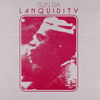Sun Ra, "Lanquidity"
 Sun Ra is one of the most challenging and innovative composers of the 20th century. He has a stupefyingly enormous discography, he espoused an enigmatic philosophy of cosmic proportions, and his music is often full of dense and unconventional sounds. Knowing where to start can be difficult, digesting his more experimental recordings even more so. For these reasons, and because of its once rare status, 1978's Lanquidity has long been among the most coveted Sun Ra records. It blends the Arkestra's characteristically obtuse performances and noisy tendencies with strong melodies, fat bass lines, and relatively straightforward rhythms. It's an excellent record for beginners and maybe the most accessible Sun Ra album ever recorded.
Sun Ra is one of the most challenging and innovative composers of the 20th century. He has a stupefyingly enormous discography, he espoused an enigmatic philosophy of cosmic proportions, and his music is often full of dense and unconventional sounds. Knowing where to start can be difficult, digesting his more experimental recordings even more so. For these reasons, and because of its once rare status, 1978's Lanquidity has long been among the most coveted Sun Ra records. It blends the Arkestra's characteristically obtuse performances and noisy tendencies with strong melodies, fat bass lines, and relatively straightforward rhythms. It's an excellent record for beginners and maybe the most accessible Sun Ra album ever recorded.
Because of previous encounters with Sun Ra's music, I was surprised by what I heard in the opening moments of Lanquidity. The title song features a plodding rhythm beat out by percussionist Michael Anderson, horn solos cool enough for an early Miles Davis record, and space enough to identify the many fractured tones that materialize around Richard Williams' weighty bass line. It is impressive that, with more than 14 Arkestra members on board, nearly every one of them gets the chance to speak up before the first song is out. Keyboards, synthesizer noise, oboe, flute, bassoon, and various horns (one of them played by Eddie Gale) take turns chattering or singing over the foundation of Anderson and Williams' somnambulistic rhythm section. The Arkestra's ingenious blending of simple rhythms and melodies with angular bursts of noise and interwoven phrases makes concentrating on the music's many complexities easier. The sometimes jarring juxtapositions of sax honking and squealing woodwinds are transformed into colorful, ecstatic, and pleasing expressions, like fireworks exploding over a familiar scene. And the often vibrant, strongly melodic solos are made that much more attractive by the atonal harmonies and contrasting elements that swirl throughout the song. Each musician plays off the other musician in such an effortless and easy-sounding way that I'm tempted to think Sun Ra notated each and every last note of the song, right down to the most nuanced dynamics. "Lanquidity" is a masterwork of arrangement and performance, and one of the best opening songs to an album that I've ever heard.
But things only get better from there. "Where Pathways Meet" is brisk and far more upbeat, almost danceable. Williams' bass, Sun Ra's piano, and a baritone sax combine to form a basic melodic pattern with a boastful, heavy swagger while a trio saxophones bluster a melody over it that swings so hard it rocks. Michael Anderson and second percussionist Artaukatune slam out a sample-worthy backbeat that is met by more blaring horns, a pair of dueling electric guitars, and a from-the-gut trumpet solo so emotive it outshines everything the Arkestra and both guitarists can pump out together. On each of the following songs, the same basic idea is employed: Sun Ra combines attractive and catchy melodies and rhythms with spaced out, often impressionistic instrumental voices that are more painterly than they are musical. It is astonishing that the Arkestra keeps this same basic formula compelling throughout the entire album. The rhythms, melodies, solos, and tapestry-like arrangements on each song are all memorable, layered, and exciting, and they've yet to get old, though I've played this record countless times in the last couple of months. Whether or not anyone could dance to this stuff, the music commands the body just as well as it commands the imagination, and I think that is one of the reasons it is so enduring.
"There Are Other Worlds (They Have Not Told You Of)" concludes the album in a more abstract and disjointed way. A constant rhythm section still leads the song, at least at first. But, Sun Ra adds more synthesizer, wandering piano, and atonality to the proceedings. Eventually, whispering voices are added to the mix, which speak of space, music, secret knowledge, and mysterious worlds beyond our own. From start to finish, the music becomes increasingly fractured, until it is broken down into primal piano and synthesizer utterances, like a radio communication received from afar. These final moments lead naturally into Sun Ra's more abstract and difficult music, as if the album were made to prepare listeners for what comes next, whether it be a record like Interstellar Low Ways or Heliocentric Worlds Vol. 2. My natural inclination once the album has finished is to put more Ra on and follow him further into the outer reaches of music.
For those curious about the man's music Lanquidity is an excellent place to begin. More than that, it's a stupendous album that marries Sun Ra's more adventurous ideas with a soulful and catchy sound anyone can appreciate.
samples:
 




